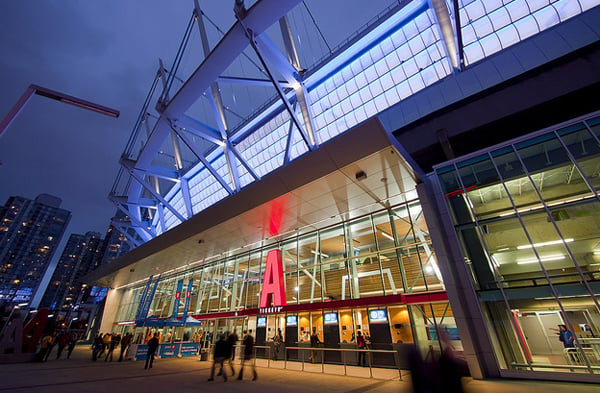The fact that B.C. Place Stadium made it to BC Hydro's Power Smart Awards of Excellence podium on Oct. 18 was a feat in more ways than one.
Samuel Brighouse Elementary School in Richmond won the new construction category of the awards, over Sysco Vancouver's expanded food supply warehouse and B.C. Place, which was renovated for $514 million.
The awards were hosted by the Vancouver Convention Centre, another B.C. Pavilion Corporation property which was a runner-up in the sustainable building design category in 2009. Both PavCo and Hydro fall under the auspices of Deputy Premier Rich Coleman's vast cabinet portfolio.
B.C. Place estimates it has cut electrical use by 38 per cent by using more efficient field of play lighting, LED lighting on the exterior, and by replacing the bronze-tinted mezzanine glass with blue/green-tinted glass.
But PavCo wouldn't provide a copy of its award's nomination form. Spokesman Trevor Pancoust said the only copy was sent to BC Hydro. BC Hydro spokeswoman Simi Heer said it contained customer information, so it couldn't be released to the media. She also admitted that the most basic measurements weren't used in gauging the stadium's Power Smartness.
"No, we did not use their monthly power bills," Heer said via email. "The technical reviews that verify the savings don't generally look at customer bills."
Savings under a new roof
The old, 1982-inflated fabric roof ripped and collapsed because of snow, ice and slush on Jan. 5, 2007. Stadium management tried saving money by using no steam to heat the roof and melt snow that day. A sudden air pressure spike backfired and an avalanche tore a hole in the roof.
In future winters, no expense was spared.
The stadium's last fall and winter of regular operations, before VANOC took over for the 2010 Winter Olympics, was 2008-2009. According to FOI documents, from November 2008 through February 2009, PavCo spent $1.033 million on 45.1 million pounds of steam from the neighbouring Central Heat Distribution plant.
For the same period in 2011 and 2012, PavCo spent $453,676 on 17 million pounds of steam under the new, retractable roof. A substantial savings.
The renovated stadium is now a brighter place with better public address speakers, a giant, centre-hung video board, a video screen for advertising around the 2,200-foot perimeter of level 4 and similar field-level boards during soccer games. There are 1,400 high definition TVs inside, a giant screen outside at Terry Fox Plaza and new video boards facing the Cambie Bridge and Georgia Viaduct. To top it all off, there is free, building-wide wireless Internet, with transmitters in every section.
Add it all up, and it goes a long way to explain why B.C. Place used more electricity and paid higher Hydro bills during the coldest, darkest part of its first year of reopening.
From November 2008 through February 2009, B.C. Place used 1.71 million kilowatt-hours (or an average 56,456 kWh a day) of power for a cost of $389,839.19. For the same period in 2011 and 2012, it used 1.9 million kWh or an average 68,114 kWh a day at a cost of $556,187.09. That's a difference of more than $166,000 for almost 200,000 more kWh of electricity used.
Economy boost?
NDP energy critic and Opposition House Leader John Horgan called the Power Smart program "one of the few positive aspects" of the Crown corporation over the last decade-and-half. He said to label the stadium Power Smart is misleading.
"This is another attempt to justify the hundreds of millions of dollars expended on roof improvements at B.C. Place Stadium all on the pretext that it was going to save us money. We have a facility that is used on very few dates throughout the year and is now using more electricity than it did when it started the project," Horgan said. "How that can be characterized as a net improvement is difficult to understand."
The B.C. Place calendar, from September 2011 through November 2012, lists 246 total days in use (over a 428 day period). That means there are 182 dormant days -- or six months of a 14-month period.
Only 89 days in that period are revenue-generating, public events, like sports, concerts and trade shows, where admission is charged, food and drink are sold and attendees are exposed to advertising.
There is little evidence so far that the renovated B.C. Place has given the economy a power boost. PavCo claims it produced $58 million of activity for the B.C. economy before the renovation, but that skyrocketed to $100 million afterward.
University of Alberta Prof. Brad Humphreys, a former president of the North American Association of Sports Economists, doesn't buy those pumped-up numbers. He said it's typical for boosters to vastly overstate or distort the benefits in a bid to justify the expense.
"Many people who would like to have these subsidies or think the subsidies are good would claim that they pay a dividend or return to cities, in that they're engines of economic growth," Humphreys said. "But if you look at the economic experience of cities across North America over the last 30 years you'll find no evidence that sports teams or facilities are engines of local economic growth. That is, it does not appear that they were linked in the past to any significant increase in employment or income per-person in the cities that were host to those teams and facilities." ![]()
Read more: Energy, Politics, Environment
















Tyee Commenting Guidelines
Comments that violate guidelines risk being deleted, and violations may result in a temporary or permanent user ban. Maintain the spirit of good conversation to stay in the discussion.
*Please note The Tyee is not a forum for spreading misinformation about COVID-19, denying its existence or minimizing its risk to public health.
Do:
Do not: